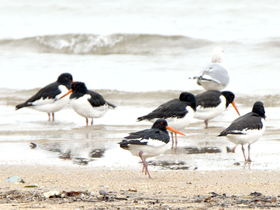The Eurasian Oystercatcher widely occurs throughout the Eurasia Continent. The global population is estimated to 1,100,000-1,200,000 individuals. However, the population on the East Asia Australasian flyway is so small, and is estimated 10,000. The Japanese Archipelago lays in this flyway, but only 300 to 400 birds were recorded in the National Wader Count.
--- Aiming to subscribe Ramsar Convention ---
A large part of the natural sandy shore in central Japan has been reclaimed and changed into ports and factories in late 20 century. However, the western shoreline of Ise Bay still has natural sandy beach, tidal flat and estuary of river, where many waders and other water birds visit and stay for foraging.
 Northern Goshawk, Gray-headed Hark, Hodgson’s Hawk Eagle, and Eastern Marsh Harrier regularly breed in our area, Mie. The breeding territories of these birds of prey are sometimes threatened by various development, road construction, wind farm construction and etc. Our society monitored the breeding of these birds of prey in some areas, and the results are used for the conservation of their territories.
Northern Goshawk, Gray-headed Hark, Hodgson’s Hawk Eagle, and Eastern Marsh Harrier regularly breed in our area, Mie. The breeding territories of these birds of prey are sometimes threatened by various development, road construction, wind farm construction and etc. Our society monitored the breeding of these birds of prey in some areas, and the results are used for the conservation of their territories.
This species is a closed relative of Western Marsh Harrier occurs in Europe. The range of this harrier is from the Lake Baikal to the eastern tip of Eurasia continent. Although a large number of this harrier winters in Japan, most of them come from the breeding area in Eurasian continent. Only a small number of the harrier breeds in Japan. The number of the breeding pair is estimated only 100. The breeding area is mainly in northern Japan including Hokkaido.
In this brochure, we listed some areas important for conservation of wild bird. Most of them are familiar to bird watchers and to local people. The brochure is written in Japanese.















